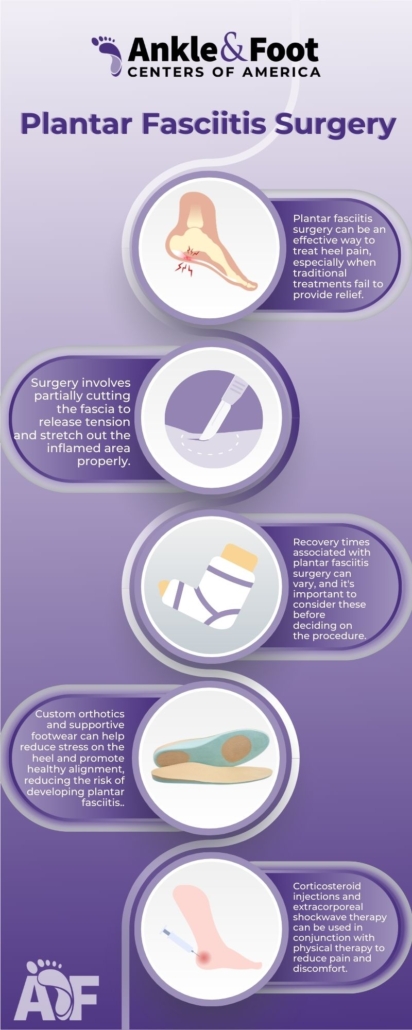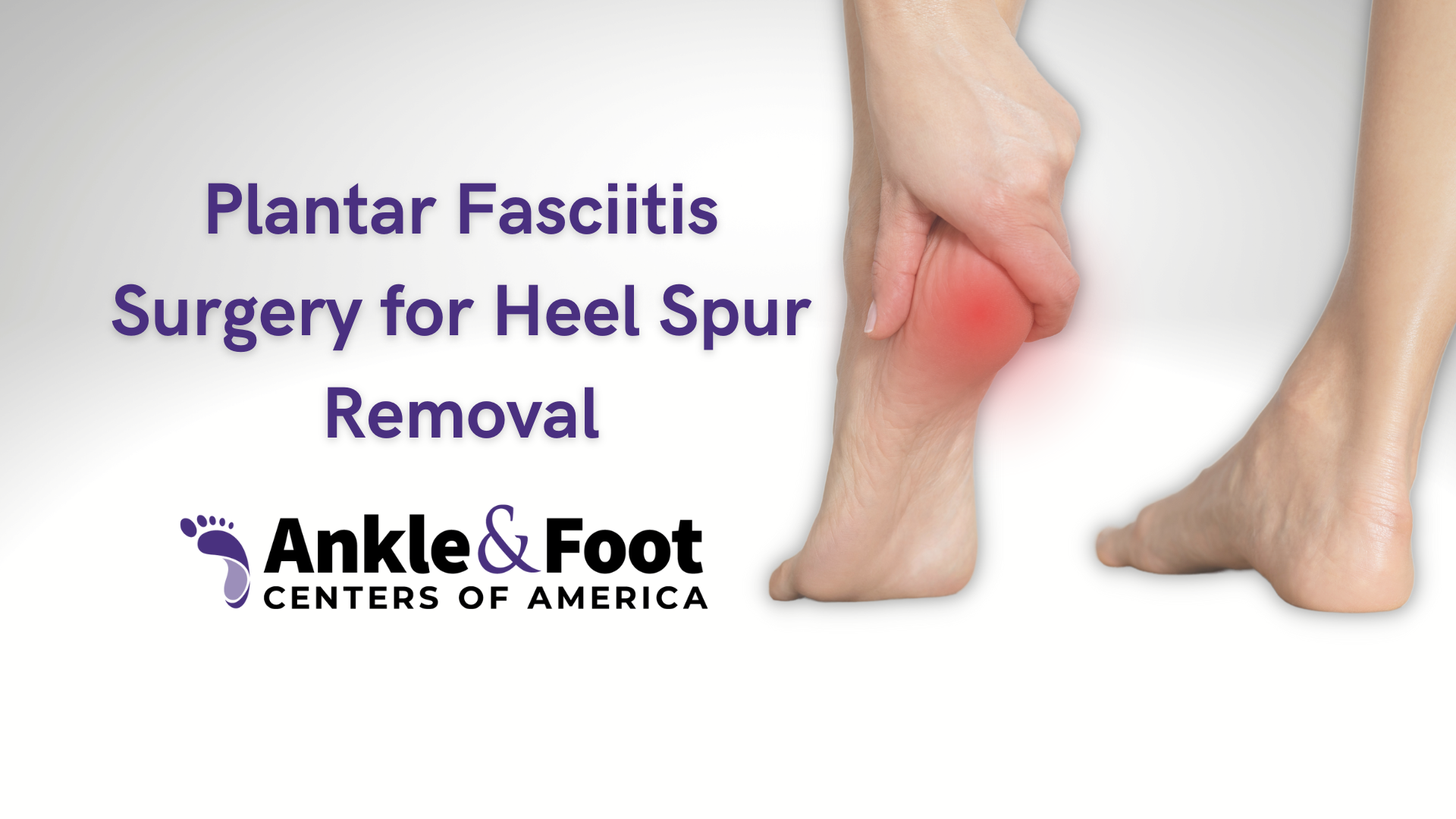 If you suffer from a heel spur, you may be wondering if surgery is the right option for you. Plantar fasciitis surgery can be an effective way to treat this condition, and in some cases, it may be the only way to relieve your pain. In this blog post, we’ll discuss what Heel Spur Removal surgery involves and whether or not it’s the right choice for you.
If you suffer from a heel spur, you may be wondering if surgery is the right option for you. Plantar fasciitis surgery can be an effective way to treat this condition, and in some cases, it may be the only way to relieve your pain. In this blog post, we’ll discuss what Heel Spur Removal surgery involves and whether or not it’s the right choice for you.
Heel pain can lead to difficulty in performing regular activities and cause disruptions in daily life. Treatments for plantar fasciitis vary from person to person as well as the severity of symptoms, but many cases will require plantar fasciitis surgery. Surgery may be necessary in certain cases where heel pain persists, or if there is an existing heel spur present. While Heel Spur Removal is the most effective method of treating plantar fasciitis, it is also important to consider the recovery times associated with this procedure.
Table of Contents
What to Know About Heel Pain
Heel pain is an incredibly common discomfort that affect many people globally. It can be caused by a range of issues, from overexertion while running or playing sports to broken bones, among other potential causes. Oftentimes, the pain radiates from the heel and can involve other parts of the foot. In many cases, individuals who suffer from heel pain will find it difficult to walk or wear their regular shoes with any level of comfort. Additionally, exposure to cold temperatures can often worsen the pain and make it harder for those who are dealing with heel discomfort to take part in everyday activities without a certain degree of difficulty.
Heel Pain Treatment
Heel pain can be debilitating, but with the right knowledge and treatment it can be effectively managed. This blog post is designed to provide a comprehensive overview of heel pain, what treatments are available, and how to recognize associated symptoms of plantar fasciitis and heel spurs. We will discuss the causes of heel pain, review the range of treatments from nonsurgical methods such as custom orthotics and physical therapy, to surgical interventions such as plantar fascia release and calcaneal osteotomy.
We will also explore lifestyle modifications that limit physical aggravation of this common condition. Taking a proactive approach to understanding heel pain symptoms, treatments and prevention strategies can help ensure proper management of your condition. Our goal is to help you understand your options so that you feel informed and empowered when discussing a personal plan for your recovery with your healthcare provider.
Plantar Fasciitis Treatment
Heel pain is a common symptom seen in many patients, especially those with tight hamstrings or Achilles tendons. Fortunately, there are a variety of treatments available which can help reduce heel pain and discomfort. At its most basic level, treatment begins with rest and activity modification – avoiding activities that cause increased heel pain or inflammation. Stretching and strengthening exercises are also critical to reducing heel pain; engaging the deep foot muscles strengthens the arch and improves shock absorption during movement. The use of orthotics like custom-made insoles can also be beneficial for controlling abnormal stresses placed on the feet, helping to decrease inflammation. In more severe cases, injections and physical therapy may be needed to control the symptoms. No matter the severity of your heel condition, it’s important to find an appropriate treatment plan to keep it from getting worse!

Wearing Supportive Shoes and Custom Orthotics
Living with heel pain can be a frustrating and life altering experience. Many people are just resigned to the idea that it is something they must manage. However, there is hope for those who suffer from heel pain; wearing supportive shoes and custom orthotics can provide relief from chronic or acute pain. The importance of proper quality footwear can’t be underscored enough, as it provides stability and cushioning around the foot to reduce stress in the heel area. Custom orthotics further take this process to the next level by providing individualized shock absorption tailored to an individual’s unique biomechanics, promoting healthy alignment that can help reduce stress on the affected area. Together these two therapies provide individuals with an opportunity to maintain active lifestyles without continuing to experience unnecessary discomfort.
Corticosteroid Injections and Extracorporeal Shockwave Therapy
If you are dealing with persistent heel pain, rest assured that there are options available to help you find some relief. Corticosteroid injections and extracorporeal shockwave therapy are two treatments which have proven helpful in reducing the pain and discomfort associated with chronic heel conditions. Corticosteroids injections can reduce inflammation and offer short-term symptom relief, while shockwave therapy works to promote healing in targeted areas of the heel. It is important to note that these treatment options should not be used as sole treatments – they should be accompanied by physical therapy in order to provide maximum benefit. Do not let persistent heel pain prevent you from living life to its fullest – talk to your doctor today about the possible benefits of corticosteroid injections and/or extracorporeal shockwave therapy!
Plantar Fasciitis Surgery
If traditional treatments for plantar fasciitis fail to provide relief, surgery may be necessary to alleviate the inflammation of the plantar fascia, a thick band of tissue that connects the heel bone to the toes and top of the foot. The surgical procedure involves partially cutting the fascia to release tension and allow the inflamed area to stretch out properly, while any scar tissue around the ligament may also be removed. While surgery may not always provide a complete resolution of symptoms, it can reduce pain and repair structural damage caused by years of overuse or chronic misalignment due to poor posture or improper footwear.
It’s essential to discuss all possible options with a doctor before deciding on a surgery for Plantar fasciitis. The condition typically caused by overuse and repetitive strain of the tendon and ligaments, resulting in inflammation and sharp, stabbing pain in the heel. If conservative treatments such as rest, ice, and medication are ineffective, plantar fascia release surgery may be considered. This procedure involves cutting the tissue connected to the heel bone to release tension along the tendon and increase ankle mobility. While generally safe, surgery for plantar fasciitis carries risks such as infection and blood clots, so it’s crucial to consult a medical specialist before embarking on this type of treatment for better outcomes.

Heel Spur Surgery Recovery Time
 Plantar fasciitis surgery is often a drastic step for many people living with the condition, and it is important to know the realities of the recovery period afterwards. Generally speaking, the initial two-week period will require plenty of rest and ice to aid healing, while anyone engaging in physical activity should do so minimally. Following this, depending on individual circumstances, physical therapy may be recommended to help with the rehabilitation process. During any physical activities like stretching or running after that point, caution must be taken in order to not overexert yourself and damage your foot further or make your healing slower. It is also important to be aware of any potential risks associated with the procedure before undergoing a surgery – as with any surgical procedure there is risk involved and potential complications that might arise. While surgery can have a really positive impact for those who suffer from plantar fasciitis for many years, it still remains key to fully understand both the risks and benefits in order to make an informed decision about what path you choose to take.
Plantar fasciitis surgery is often a drastic step for many people living with the condition, and it is important to know the realities of the recovery period afterwards. Generally speaking, the initial two-week period will require plenty of rest and ice to aid healing, while anyone engaging in physical activity should do so minimally. Following this, depending on individual circumstances, physical therapy may be recommended to help with the rehabilitation process. During any physical activities like stretching or running after that point, caution must be taken in order to not overexert yourself and damage your foot further or make your healing slower. It is also important to be aware of any potential risks associated with the procedure before undergoing a surgery – as with any surgical procedure there is risk involved and potential complications that might arise. While surgery can have a really positive impact for those who suffer from plantar fasciitis for many years, it still remains key to fully understand both the risks and benefits in order to make an informed decision about what path you choose to take.
Heel Spur Symptoms
Heel Spurs can cause a wide variety of symptoms depending on the severity and area in which they are affected. The primary symptom is pain in the heel area, which may be sharp or dull and range from mild to severe. This pain may worsen over time if left untreated. Heel spurs can also cause swelling, redness, stiffness or even numbness at the site of the spur. Depending on your activity level, this type of pain can interfere with your daily activities and even make it difficult to stand for long periods of time. In addition, some patients may experience a grinding sensation underfoot when walking or running. It’s important to seek medical attention right away if you begin to experience these symptoms so that you don’t end up with an injury that could take months to heal.
Diagnosing Heel Spurs: X-rays or Other Imaging Tests
Heel spurs, small bony growths on the heel bone, can be an extremely painful and debilitating foot condition. While they are very common – seen in up to twenty five percent of adults who suffer from heel pain – they can also be difficult to diagnose and detect. Thankfully, modern medical technology has given us a variety of imaging tests that can be used to accurately diagnose heel spurs, including X-rays and other methods such as computed tomography (CT) scans and magnetic resonance imaging (MRI). By using these methods, doctors are able to identify the presence of inflammatory, bony calcifications and get a better idea of what type of treatment may be necessary for successful symptom management. With proper treatment and care, heel spurs don’t have to stand in the way of living an active lifestyle.
When to See a Podiatrist?
How do you know what doctor to see for heel pain? It is important to take persistent heel pain seriously as it could indicate underlying or chronic conditions that require medical attention. Early prevention is key in many cases; if left unchecked, heel pain may become worse over time or lead to further complications. Some causes of heel pain could include plantar fasciitis, Achilles tendonitis, or even stress fractures—all grievous conditions that should be addressed by a physician for proper diagnosis and treatment. Don’t wait until the issue becomes unbearable before taking action – seeking medical advice early on when you notice any signs of discomfort from your feet can make all the difference in outcomes, so do not delay in making an appointment.
Foot Health is Key to Staying Active!
Foot health should always be a priority, just as going to the doctor for regular check-ups is a must. Your feet are essential for your mobility, and if you neglect any existing or potential issues, it can lead to long-term damage or disability. If your feet are affected by constant pain, swelling, deformity or have difficulty tolerating prolonged walking and standing activities then medical attention is necessary. Don’t risk it–see a medical professional before it’s too late!






